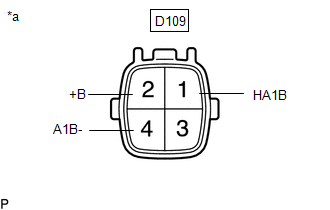Toyota Yaris: Air Fuel Ratio Sensor (for Sensor 2) / Inspection
INSPECTION
PROCEDURE
1. INSPECT NO. 2 AIR FUEL RATIO SENSOR
| (a) Measure the resistance according to the value(s) in the table below. Standard Resistance:
If the result is not as specified, replace the No. 2 air fuel ratio sensor. |
|
 Removal
Removal
REMOVAL CAUTION / NOTICE / HINT The necessary procedures (adjustment, calibration, initialization, or registration) that must be performed after parts are removed, installed, or replaced during the No...
 Installation
Installation
INSTALLATION PROCEDURE 1. INSTALL NO. 2 AIR FUEL RATIO SENSOR (a) Using SST, install the No. 2 air fuel ratio sensor to the front exhaust pipe assembly...
Other information:
Toyota Yaris XP210 (2020-2025) Reapir and Service Manual: Fuel Pump Ecu
ComponentsCOMPONENTS ILLUSTRATION *1 FUEL PUMP CONTROL ECU BRACKET *2 FUEL PUMP CONTROL ECU *3 DECK TRIM SIDE PANEL ASSEMBLY RH - - N*m (kgf*cm, ft.*lbf): Specified torque - - InstallationINSTALLATION PROCEDURE 1. INSTALL FUEL PUMP CONTROL ECU BRACKET (a) Install the fuel pump control ECU bracket to the fuel pump control ECU with the 2 bolts...
Toyota Yaris XP210 (2020-2025) Reapir and Service Manual: Disassembly
DISASSEMBLY CAUTION / NOTICE / HINT NOTICE: When removing and installing the combination meter glass, make sure not to touch the display panel. Do not allow any dirt (fingerprints, grease, etc.) to adhere to the combination meter glass. If the glass is dirty, wipe it clean with a soft cloth...
Categories
- Manuals Home
- Toyota Yaris Owners Manual
- Toyota Yaris Service Manual
- Adjustment
- To Set Speed
- Auto Lock/Unlock Function
- New on site
- Most important about car
Break-In Period
No special break-in is necessary, but a few precautions in the first 600 miles (1,000 km) may add to the performance, economy, and life of the vehicle.
Do not race the engine. Do not maintain one constant speed, either slow or fast, for a long period of time. Do not drive constantly at full-throttle or high engine rpm for extended periods of time. Avoid unnecessary hard stops. Avoid full-throttle starts.
Copyright © 2025 www.toyaris4.com

